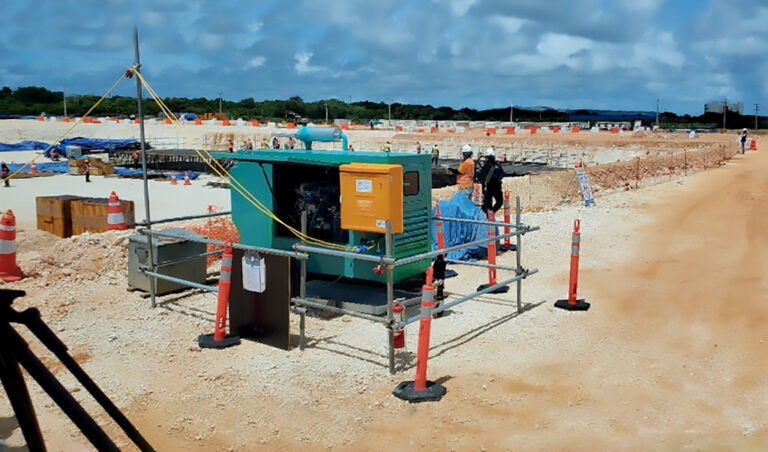
Jeffrey Waksman
While the U.S. Department of Defense (DOD) continues to beef up its presence on Guam and shore up its combat readiness, rolling power outages continue islandwide.
The military accounts for about 20 percent of power consumption on Guam, with the Guam Power Authority (GPA) remaining as the island’s main electricity provider.
But the instability of Guam’s civilian power grid places the military in a precarious situation as its electrical demands continue to grow.
“Energy that’s been used per soldier in the DOD has risen exponentially,” says Jeffrey Waksman, program manager for the Strategic Capabilities Office in the Office of the Secretary of Defense (OSD). “All these huge radar systems that you’ve probably seen around the island use colossal amounts of energy. And so, energy is a huge challenge.”

Project Pele’s target is to build and demonstrate a prototype mobile nuclear reactor within five years.
PROJECT PELE
Waksman heads the OSD’s Project Pele, a prototype demonstration of mobile nuclear microreactors.
Launched in 2016, Project Pele was spawned by a Defense Science Board report that analyzed the United States’ energy situation. Recommended solutions include portable microreactors that can generate up to five megawatts of electricity and are transported by truck, rail or plane to forward operating bases.
Guam is among the U.S. locations being eyed for the prototype.
“Island locations are ideal for something like nuclear power because energy resiliency is a lot harder when you’re on an island,” Waksman says.
In January, Waksman led a U.S. team that visited Guam for a location survey to evaluate how Project Pele’s current prototype may or may not apply to the island.
“For the prototype in Idaho, we’re going to have a fence that’s about 200 yards in radius around it,” he says. “The design that we’re building is in 420-foot containers. If you wanted more power, you might have to have a bigger container.”
The existing prototype is sized for current requirements, which is one to five megawatts of net electrical power for at least three years at full power operation, Waksman adds.
The system has four boxes, each containing a reactor, heat exchanger, power converter and computer controls. The reactor can be installed either above ground or buried underground.
GETTING MICROREACTORS TO GUAM
For Guam, Waksman says, the ideal option is to have it sit on the ground.
“The reactor itself has a huge amount of shielding, with very hard material around it,” he says. “And around that, we will build up a combination of dirt and concrete to provide additional ballistic protection.”
Burying the reactor underground may be out of the question, however.
“One of the things we’ve certainly learned in Guam is that trying to dig into the ground is probably not a good idea,” Waksman says. “So while in other places you might want to bury a nuclear reactor, that seems probably not a good solution on Guam.”
Project Pele’s target is to build and demonstrate a prototype mobile nuclear reactor within five years. The project is coordinated with the U.S. Department of Energy and the U.S. Army Corps of Engineers. Its goal is to provide reliable and resilient power while minimizing the risk of nuclear proliferation and environmental damage.
LOCATION-SPECIFIC CONCERNS
Guam has particularly unique cultural concerns.
“There are specific locations that are culturally sensitive. There’s the drinking water concern,” Waksman says.
Climate is another factor to consider. Given Guam’s all-year-round high humidity, corrosion is a big concern for anything metallic.
“I’d say those are probably some of the big ones that we’ve gathered from here,” Waksman says.

The Ukudu project hit a snag following Typhoon Mawar.
Guam’s power grid has also been unstable in recent years, with GPA’s aging plants enduring constant repairs and some power projects stalled by procurement protests.
Typhoon Mawar, which left Guam in shambles in May 2023, also exacerbated GPA’s predicament, destroying infrastructure and cutting GPA’s reserve capacity by 20 megawatts.
Pending complete site assessments and discussions with local leaders, the plan is purely “academic” at the current stage. But Waksman says Guam remains an ideal location to push nuclear energy.
“We’re just studying what the current energy uses and what the current energy challenges are,” he says.
LOOKING AHEAD
The Ukudu project, a 198-megawatt combined cycle power plant, which was originally scheduled to open in April, hit a snag after sustaining significant typhoon damage.
In January, contractor Doosan Ukudu Power LLC announced the final segments and placement of the plant’s 2.08-mile fuel lines. The installation is expected to be completed by June 30, according to Lance Osborn, spokesperson for Doosan.
Meanwhile, the Consolidated Commission on Utilities (CCU) has approved GPA’s contracts for two emergency power projects that would potentially add up to 54MW of energy to Guam’s power grid over the next six to nine months. The projects will provide a short-term solution to bridge the gap in Guam’s power capacity while awaiting the completion of the Ukudu project.

John Benavente
“We are pleased to see the CCU’s endorsement for our short-term projects, which are crucial in addressing the challenges affecting power generation on Guam,” says John Benavente, GPA general manager.
GPA has awarded a contract to Aggreko for 20MW of temporary power within 100 days, and at the same time has negotiated the repair of up to 18 Yigo diesel units to restore an additional 12- to 14-megawatt capacity at the Yigo diesel site.
GPA says it anticipates the restoration of a typhoon-damaged 20MW Yigo combustion turbine in March, which will add about 74MW to the island-wide power system. The utility corporation also identified an alternate site adjacent to the Tenjo Vista Power Plant to place up to 20MW of additional capacity to serve southern villages and Naval Base Guam.
In the meantime, GPA has resorted to monthly load shedding and rolling power outages.
“We’ve met with the folks at Guam Power Authority, and they talked to us about how they recognized that they have a much harder challenge here than someone does running a power authority in the contiguous 48 states,” says Waksman, noting that Guam’s reliance on fossil fuels is not sustainable.
“The process of just moving millions and millions of gallons of fossil fuel across the ocean constantly is just not a practical solution. That’s why we’re looking at all sorts of options — not just nuclear power.
“We’re also looking at tidal power, geothermal power, just anything that is not fossil fuel, and something that can provide super-reliable power 24/7 in a place like this, or any islands,” he says.




